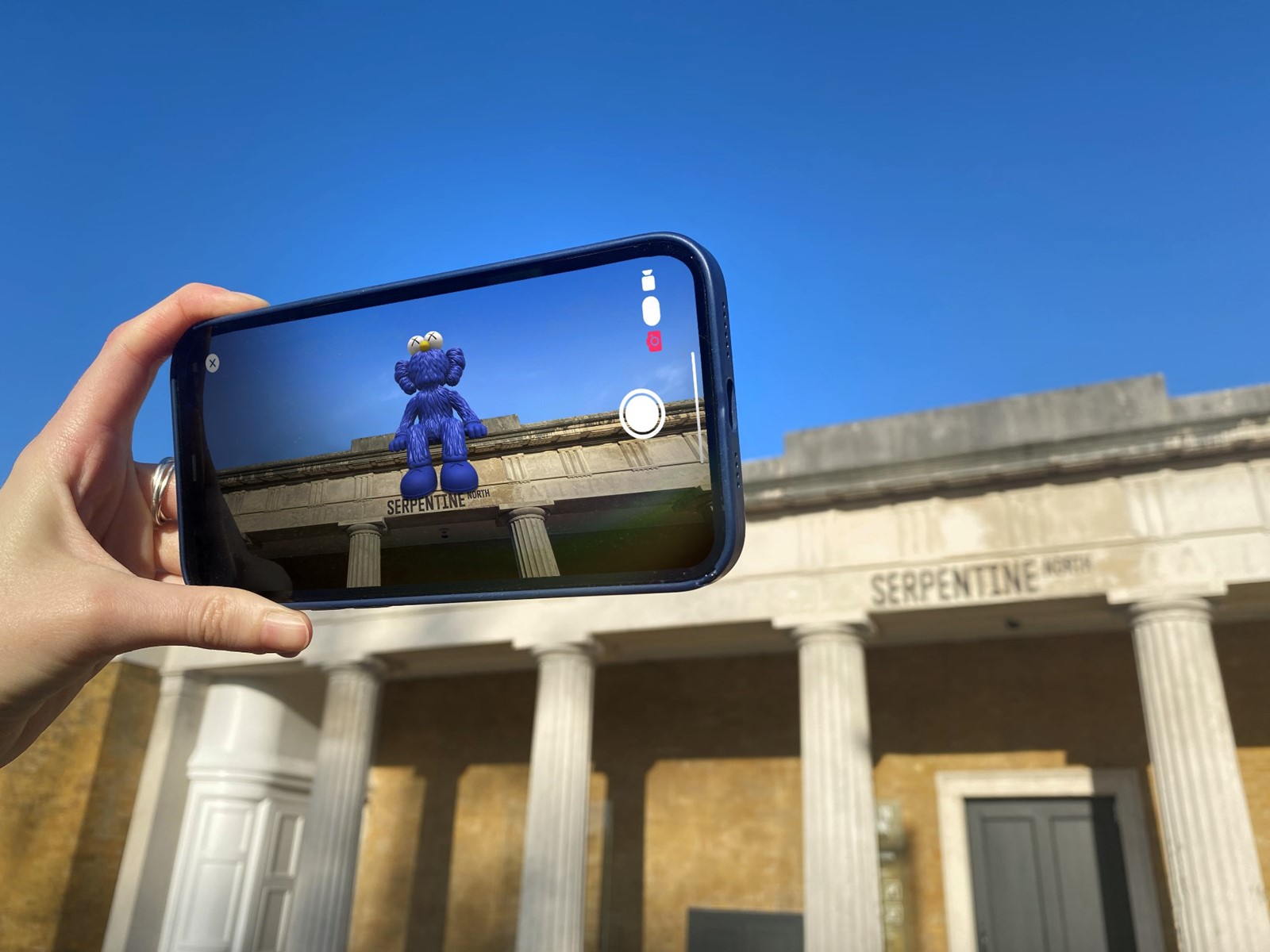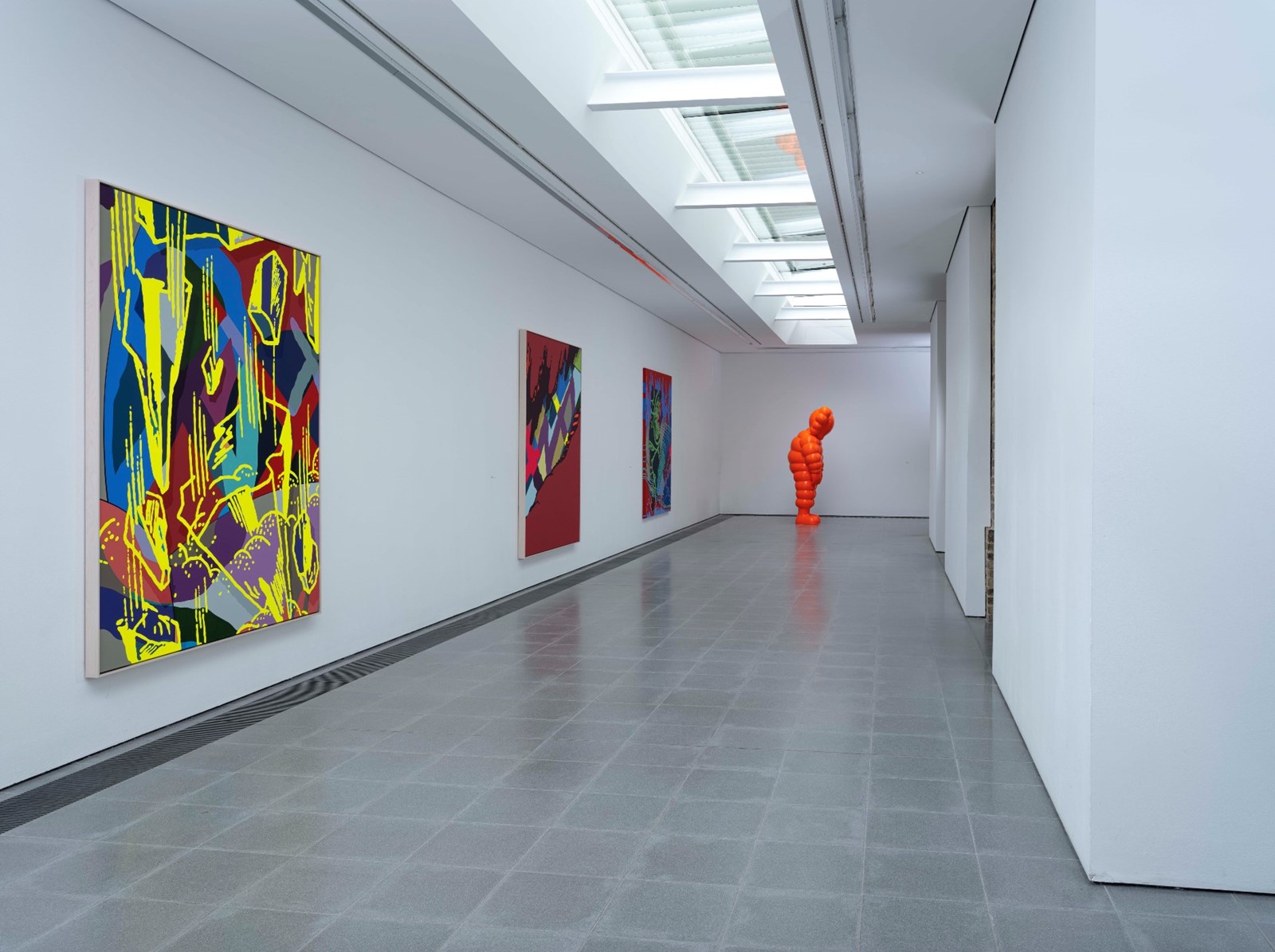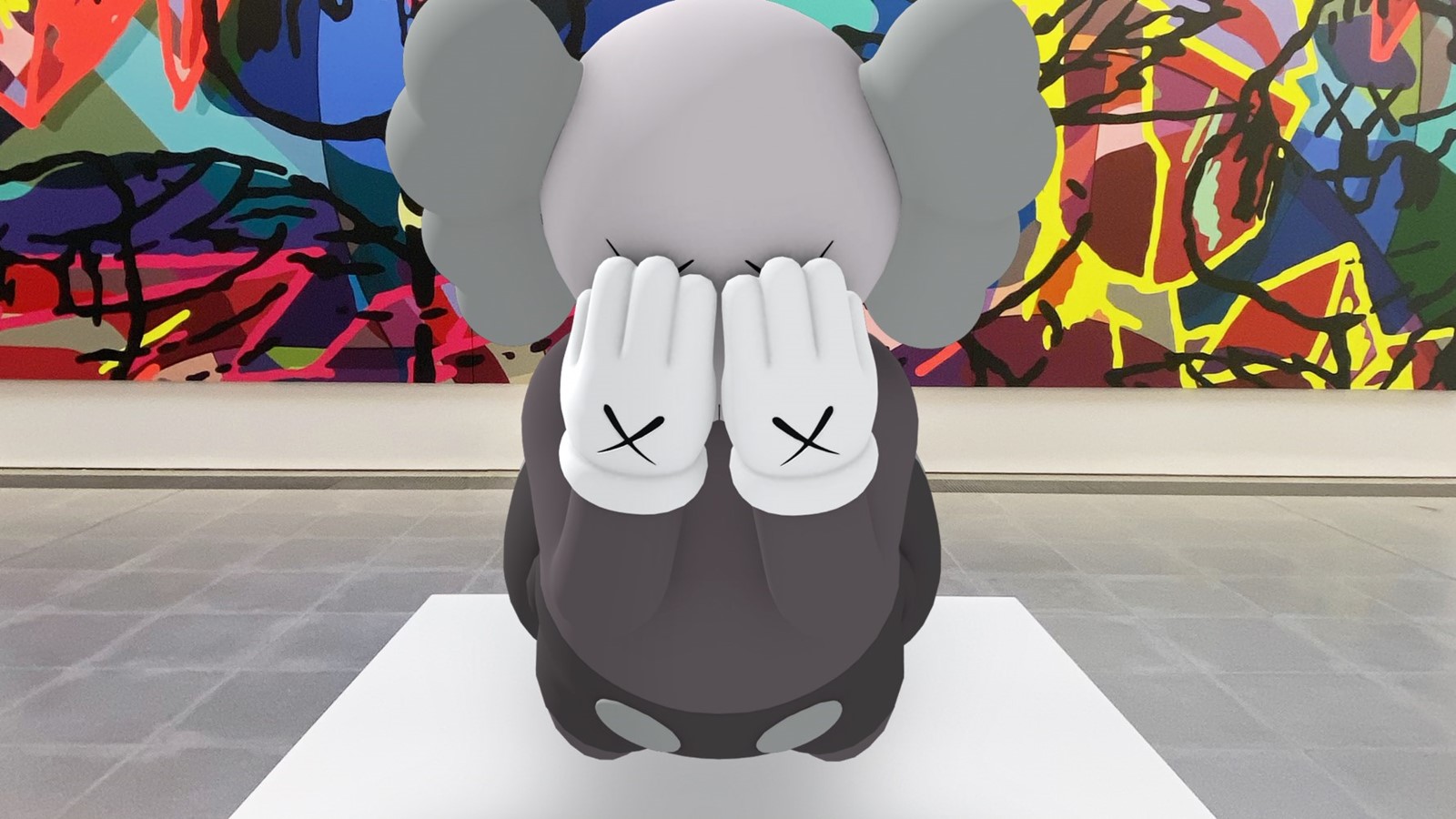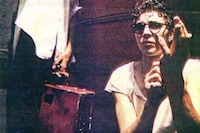His first major solo show in London is also the very first exhibition recreated in Fortnite’s multiverse. We speak to the artist about what it means for the future of art
Before KAWS’ – AKA Brian Donnelly’s – first major solo exhibition in London, NEW FICTION, had even opened its doors, it was being touted as the most attended show ever. Thanks, in part, to its collaboration with AR app Acute Art and gaming phenomenon Fortnite, which has recreated the Serpentine North Gallery in all its glory in the multiverse.
It’s the first time a ‘real’ art gallery has been built in the game, enabling players from all over the world to roam the London institution and its gardens as a KAWS Skeleton. To put the footfall potential into art world terms, at the press preview, Acute Art’s artistic director Daniel Birnbaum predicted that it “will reach an audience ten times bigger than the Venice Biennale.”
Much-loved Companion and Chum sculptures share the space with KAWS’ paintings from the last decade. Visitors who download the Acute Art app can also experience digital-exclusive works through their phones, either on-site or at home. Outside, “COMPANION (EXPANDED)” (2020) floats by the entrance and “KAWS, SEEING” (2022) sits on the roof, welcoming us in.
The reception of the show has been polarising. “What was the Serpentine thinking?” bemoaned art critics. But this isn’t simply about what happens within the walls of the Serpentine: i’s a collaboration of one of the most engaged artists of the 21st century and one of the most engaged communities, gamers. Earlier this week, Artnet published feedback from the gamers who had experienced the show. The consensus was that they were excited to access and interact with it, especially in a video game, with some revealing they had never been to an art gallery before.
This makes me think that NEW FICTION has less to do with KAWS himself and more with the possibilities it offers. There’s symbolism at play. As the first ‘real’ art gallery built in Fortnite, NEW FICTION bridges an alienating and intimidating world, art, with an accessible yet overlooked one, gaming. Instead of making gamers come to it, it meets them where they are. The medium is the message, and with more than 80.4 million Fortnite monthly active users, NEW FICTION says, ‘get on board or get left behind.’
The morning after the opening, I caught up with Donnelly to speak about reaching new audiences, navigating criticism, and how his kids have influenced his practice.

Congrats on the show opening! It’s great to see both the physical and the digital works collide. Has technology changed the way that you make work?
KAWS: Yeah. Definitely. The first piece I made with Acute, “EXPANDED HOLIDAY”, originally existed as a float for the Thanksgiving Day Parade in New York. I really had no application for it after that; it wouldn’t make sense to make it as an object and lay it on a table. Then when the project with Acute came, suddenly I could have a sculpture that could levitate and leave a shadow on the floor.
That was just ahead of the pandemic, wasn’t it?
KAWS: It was launched on March 12, 2020. It was hosted by Apple and we had geotagged sculptures all over the world. We were imagining this large public art augmented reality exhibition, and then it all just shut down. It’s funny that the whole week before, I had a friend documenting the process. I was in Times Square and Penn Station, talking to strangers, handing them my phone, showing them AR. Looking back at the footage, it’s like looking at a horror flick (laughs).
Your characters are so loved, recognised, and sought-after, why are you so drawn to those pop culture, cartoon figures?
KAWS: I just think it’s a universal aesthetic. I like working with that imagery because it’s almost like working with a person that you can use to communicate your observations, feelings. I never thought of Companion as having this narrative, but over the years, it’s developed with me.
Your art spans different accessibility points, like $200 figures, public sculptures, or AR on Acute Art. It reminds me of Keith Haring’s Pop Shop. Is making works available to all something you’re conscious of?
KAWS: Yeah. To be able to participate in it. It would be really boring if I were just pleasing a very small audience – that’s very comfortable. I like the idea of having the work out there, in different countries with kids I might not cross paths with. Especially with Acute, it really lets it go global instantly, from when we upload something – and it’s free.
Critics and purists can be quite hostile about your work. Often dismissing it as street art. Do you think it’s because they don’t understand it?
KAWS: I really can’t say what lens people who criticise it are seeing it through, but it’s obviously not something that speaks to them, and that’s totally fine. I’m not here to try to make people like a certain body of work, or a certain way of working. For me, working in all these different outlets is the most honest way I can work. It’s mostly, truly, what I want to be doing. Things have changed over the years, it’s definitely opened up, and there’s a lot more acceptance about the different genres.

Would you consider yourself an outsider to the art world?
KAWS: I don’t know how to place it. All those terms are kind of strange.
Do you see yourself working with that technology more going forward?
KAWS: I think the pandemic definitely shook up a lot of the systems that existed and people are figuring out how to move forward. I see this as something that’s going to be adopted by many people. The idea of not just a physical show, but how a show exists. When artists do books for an exhibition, maybe not many people can actually get to the physical show, but then the book exists and has essays, photography, and how important that all is (to us). I think having a digital existence is going to be another layer added onto that, when you’re thinking about the preservation of ideas.
It would seem that your work would lend well to NFTs.
KAWS: I like the idea of blockchain. I like the idea of an authenticating system. I have so many problems with counterfeits and when I was first learning about it, I thought maybe that was a way around it. But I haven’t really found the right thing I would want to make. With AR, I moved slowly into it, and only when I thought it actually added to the work that I made. I know NFTs are a way to monetise, but I don’t think that’s a reason to make something.
… and the money conversation surrounding your work seems to be a frustration for you. People value it through auction prices rather than the cultural or artistic significance.
KAWS: It’s not just with me. The entire contemporary art world is obsessed with talking about the dollar value of work.
“I see this as something that’s going to be adopted by many people. The idea of not just a physical show, but how a show exists” – KAWS
That’s why people find NFTs so ‘icky’, because we’re speaking about the price of Beeple’s work, rather than what it means, or what it makes possible going forward, in terms of NFT technology.
KAWS: Beeple seems real, and I feel that came from a real place. When you see a lot of people jumping in, for the sake of just finding a way to make an NFT, I find that boring.
2018 is often noted as a significant year for you, with a lot of record-breaking auctions and a huge demand for your work. What do you think happened that made that all happen for you?
KAWS: Honestly, I don’t equate the auction results with the work reaching new heights. At that moment, there was a certain energy and demand for work, and that’s what it was. It’s hard to pinpoint or talk about because I’m not the active player in that. Sometimes it’s work that existed ten years earlier. I always feel like when you put a painting or a sculpture into the world, it has multiple lives. I like to collect work, and you see works come around and have strong points and low points and go back and forth on a trajectory, nothing stays.
Who are some of the artists that you like to collect?
KAWS: It’s pretty eclectic. I’m on the board for the American Folk Art Museum. I tend to gravitate towards a lot of outsider stuff, self-taught, as well as my peers, and my heroes. Everything from 70s, 80s Graffiti to Chicago Imagists work. It’s completely about a feeling: sometimes I’m drawn to this graphic work that could exist within the stuff I make, and other times, it’s the exact opposite of that.
I want to ask you about your process of making work, the references and influences. Take us through that a bit.
KAWS: A lot of times I like to build up image archives, things I see that stick out to me, and I might clip them or screenshot them, photograph them. Then eventually if I start to get interested in a direction, I’ll sit down, make drawings, and almost use those bits as a collage-form. I take a lot of that stuff into the computer, a lot of the imagery, and I tend to draw these really fine vector drawings of works, and those I can move around and shift and scale, and it’s from there, after I developed a drawing, that I can move into painting. It’s all freehand. I have two assistants that I paint with.
I know now that it’s not your auction prices that fulfil you, so what is it that makes you proud?
KAWS: I feel like everything adds to a whole. There are different points. There’s me gravitating towards painting billboards when I was 19. There’s the ‘package paintings’ I did in 2000. I keep going back to them, in my head, and thinking about how that was the beginning for so many ideas of commerce and painting and sculpture, and this hybrid form. AR really expanded my thinking on things. Things you don’t really think at the time are anything new, and then you realise that actually set you this whole other path.
How do you see yourself working with AR in the future?
KAWS: I think for this project here in London, I just need to give it time. I’m looking forward to having a mellow year, actually.
Oh, yeah? How does that look?
KAWS: (Laughs) I don’t know, but it’s something I’ve never done, and it’s something I really want to try. We’ll see. I have two kids, they keep me busy.
How do they respond to your work?
KAWS: It’s fun. That’s why if you see me do a collection, there’s also kids clothes. It’s things I want them to experience. They’re two little great creative people.
Do you take inspiration from their worlds?
KAWS: Yeah. I think in general, looking at how kids respond to things, it’s fascinating. It’s just complete truth, you know? It doesn’t matter who made it or what it is, they respond to it, or they don’t respond to it. And there’s no filter.
Do you have any advice for young artists?
KAWS: I never want to be like, ‘You should do this’, or ‘You should do that’, but I do think it’s important to get in your own head and figure out what you want to do. And look at others that have maybe had similar paths or portions of similar paths that could overlap with yours and get to understand them.
New Fiction is at the Serpentine Gallery until February 27, with an AR version on the Acute Art app. The exhibition is available on Fortnite now







